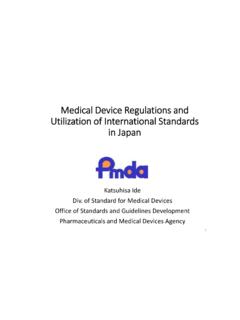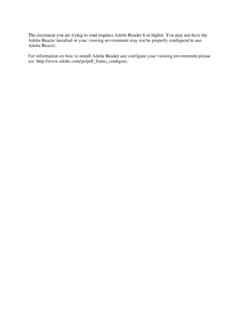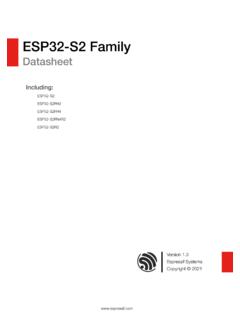Transcription of CMS Manual System
1 CMS Manual System Department of Health & Human Services (DHHS) Pub. 100-07 State Operations Provider Certification Centers for Medicare & Medicaid Services (CMS) Transmittal 27 Date: AUGUST 17, 2007 SUBJECT: Revisions to Appendix PP Guidance to Surveyors for Long Term Care Facilities I. SUMMARY OF CHANGES: This revision includes interpretive guidelines, an investigative protocol, and severity guidance for 42 CFR (h)(1) and (2) Accidents. This information is intended to replace all current text contained in the Guidance to Surveyors for current Tags F323 and F324.
2 The guidance for F323 and F324 is combined under one tag, F323. NEW/REVISED MATERIAL - EFFECTIVE DATE*: August 6, 2007 IMPLEMENTATION DATE: August 6, 2007 Disclaimer for Manual changes only: The revision date and transmittal number apply to the red italicized material only. Any other material was previously published and remains unchanged. However, if this revision contains a table of contents, you will receive the new/revised information only, and not the entire table of contents. II. CHANGES IN Manual INSTRUCTIONS: (N/A if Manual not updated.)
3 (R = REVISED, N = NEW, D = DELETED) (Only One Per Row.) R/N/D CHAPTER/SECTION/SUBSECTION/TITLE R Appendix PP/ (h)(1) and (2)/F323/Accidents D Appendix PP/ (h)(2)/F324 III. FUNDING: Medicare contractors shall implement these instructions within their current operating budgets. IV. ATTACHMENTS: Business Requirements X Manual Instruction Confidential Requirements One-Time Notification Recurring Update Notification *Unless otherwise specified, the effective date is the date of service.
4 F323 (Rev. 27; Issued: 08-17-07; Effective/Implementation: 08-17-07) (h) Accidents. The facility must ensure that (1) The resident environment remains as free from accident hazards as is possible; and (2) Each resident receives adequate supervision and assistance devices to prevent accidents. Intent: 42 CFR (h) (1) and (2) Accidents and Supervision The intent of this requirement is to ensure the facility provides an environment that is free from accident hazards over which the facility has control and provides supervision and assistive devices to each resident to prevent avoidable accidents.
5 This includes: Identifying hazard(s) and risk(s); Evaluating and analyzing hazard(s) and risk(s); Implementing interventions to reduce hazard(s) and risk(s); and Monitoring for effectiveness and modifying interventions when necessary. DEFINITIONS Definitions are provided to clarify terms related to providing supervision and other interventions to prevent accidents. Accident refers to any unexpected or unintentional incident, which may result in injury or illness to a resident. This does not include adverse outcomes that are a direct consequence of treatment or care that is provided in accordance with current standards of practice ( , drug side effects or reaction).
6 O Avoidable Accident means that an accident occurred because the facility failed to: - Identify environmental hazards and individual resident risk of an accident, including the need for supervision; and/or - Evaluate/analyze the hazards and risks; and/or - Implement interventions, including adequate supervision, consistent with a resident s needs, goals, plan of care, and current standards of practice in order to reduce the risk of an accident; and/or - Monitor the effectiveness of the interventions and modify the interventions as necessary, in accordance with current standards of practice.
7 O Unavoidable Accident means that an accident occurred despite facility efforts to: - Identify environmental hazards and individual resident risk of an accident, including the need for supervision; and - Evaluate/analyze the hazards and risks; and - Implement interventions, including adequate supervision, consistent with the resident s needs, goals, plan of care, and current standards of practice in order to reduce the risk of an accident; and - Monitor the effectiveness of the interventions and modify the interventions as necessary, in accordance with current standards of practice.
8 Assistance Device or Assistive Device refers to any item ( , fixtures such as handrails, grab bars, and devices/equipment such as transfer lifts, canes, and wheelchairs, etc.) that is used by, or in the care of a resident to promote, supplement, or enhance the resident s function and/or safety. NOTE: The currently accepted nomenclature refers to assistive devices. Although the term assistance devices is used in the regulation, the Guidance provided in this document will refer to assistive devices. Environment refers to the resident environment.
9 (See definition for resident environment. ) Fall refers to unintentionally coming to rest on the ground, floor, or other lower level, but not as a result of an overwhelming external force ( , resident pushes another resident). An episode where a resident lost his/her balance and would have fallen, if not for staff intervention, is considered a fall. A fall without injury is still a fall. Unless there is evidence suggesting otherwise, when a resident is found on the floor, a fall is considered to have Hazards refer to elements of the resident environment that have the potential to cause injury or illness.
10 O Hazards over which the facility has control are those hazards in the resident environment where reasonable efforts by the facility could influence the risk for resulting injury or illness. o Free of accident hazards as is possible refers to being free of accident hazards over which the facility has control. Resident environment includes the physical surroundings to which the resident has access ( , room, unit, common use areas, and facility grounds, etc.). Risk refers to any external factor or characteristic of an individual resident that influences the likelihood of an accident.














